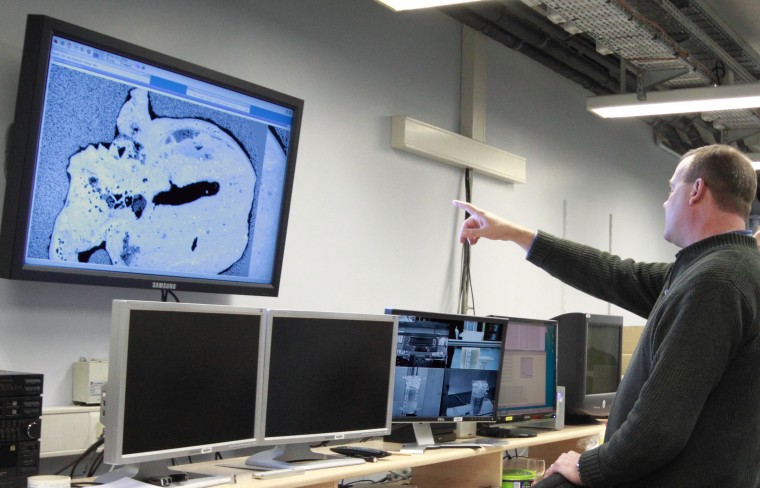Remains of a 1.9-million-year-old human ancestor are so well preserved that they may contain a remnant of the male individual's brain, according to the European Synchrotron Radiation Facility in Grenoble, France, where the remains were recently examined.
While DNA is very fragile and deteriorates over time, the discovery opens up the remote possibility that soft tissue with preserved DNA still exists in the prehistoric hominid, which could hold an important place on the human family tree.
The examination also turned up what seemed to be fossilized insect eggs, according to scientists. They said larvae from the eggs could have fed on the flesh of the human ancestor, Australopithecus sediba, right after his death.
While gazing at the hominid's skull as it was being studied with a powerful electromagnetic radiation X-ray process, project leader Lee Berger said he and his team were seeing "structures we can't even imagine in a way that's quite literally unprecedented in paleontological sciences."
Berger, a senior research officer and director of the School of Geosciences at the University of Witwatersrand, and his colleagues focused on the teeth and "parts of the body that don't normally fossilize," such as the brain. While further testing is needed, the researchers believe an "extended shadow" hints that a remnant of the brain after its bacterial decay is still present in the ancient remains.
"We actually think we have found the best candidate for a direct ancestor of Homo, the genus to which humans belong," Berger's colleague, Darryl de Ruiter of Texas A&M University, said. They and other researchers wrote a paper on Australopithecus sediba that appears in the latest issue of Science.
So far, two fossilized skeletons for this species with both primitive and more humanlike traits have been excavated. One set belonged to an adult female. The other belonged to a 9- to 13-year-old male, which underwent the X-ray synchrotron process that allows scientists to visualize minute details inside a fossil without having to break it open.
"When I first saw the skeletons, I knew we had something special," said de Ruiter. "Both were remarkably complete and extremely well preserved."
The fossilized skeletons were found deep in a South African cave, where the prehistoric individuals had likely sought water before plunging to their deaths and being buried by a roof collapse within the cave.
The researchers are not providing further details yet on the possibly detected brain segment and fossilized insect eggs, as they say the results are still "preliminary" and have not yet been published in a peer-reviewed journal.
Human brain tissues have been found dating to over 8,000 years ago, but there is little direct evidence for hominid brain structure before that time, aside from what is suggested by the shape of skulls.
"For a long time, paleontologists have used the shape of the cranial cavity to research the general morphology of the brain — because soft tissue was not available until today," said Alan Pradel of Paris' National Museum of Natural History.
Pradel was one of the scientists who recently discovered a 300-million-year-old fossilized brain in a now-extinct relative of a modern "ghost shark" chimaera.
"Soft tissue has fossilized in the past, but it is usually muscle and organs like kidneys because of phosphate bacteria from the gut that permeates into tissue and preserves its features," added the American Museum of Natural History's John Maisey, who worked with Pradel in identifying the chimaera brain, which is now believed to be the world's oldest fossil brain.
Berger and his team are at present still analyzing the "terabytes of data" from the X-ray synchrotron examination of the hominid remains. In the future, they hope to use this process to not only reveal further information about A. sediba, but also other fossils that they have found in South Africa.
